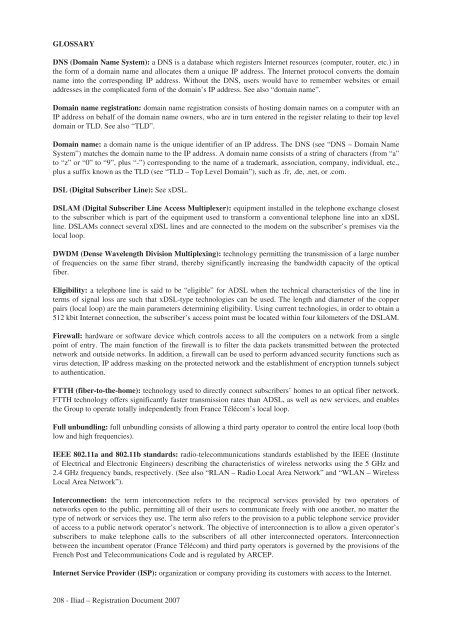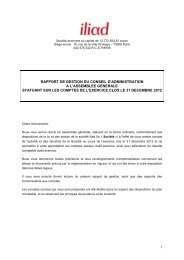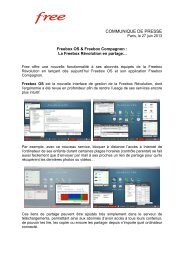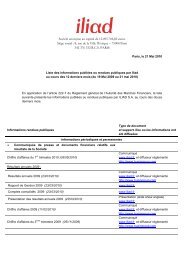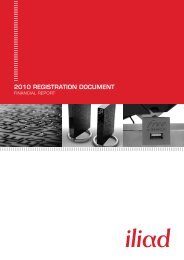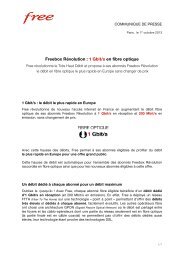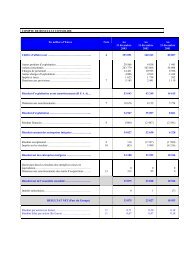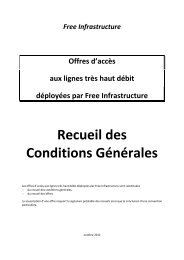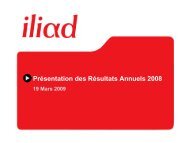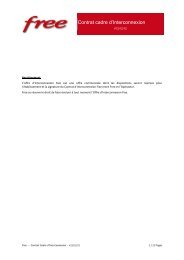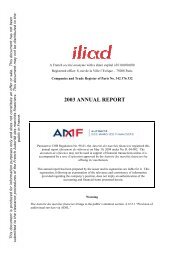REGISTRATION DOCUMENT AND FINANCIAL REPORT - Iliad
REGISTRATION DOCUMENT AND FINANCIAL REPORT - Iliad
REGISTRATION DOCUMENT AND FINANCIAL REPORT - Iliad
- TAGS
- registration
- iliad
- iliad.fr
Create successful ePaper yourself
Turn your PDF publications into a flip-book with our unique Google optimized e-Paper software.
GLOSSARY<br />
DNS (Domain Name System): a DNS is a database which registers Internet resources (computer, router, etc.) in<br />
the form of a domain name and allocates them a unique IP address. The Internet protocol converts the domain<br />
name into the corresponding IP address. Without the DNS, users would have to remember websites or email<br />
addresses in the complicated form of the domain’s IP address. See also “domain name”.<br />
Domain name registration: domain name registration consists of hosting domain names on a computer with an<br />
IP address on behalf of the domain name owners, who are in turn entered in the register relating to their top level<br />
domain or TLD. See also “TLD”.<br />
Domain name: a domain name is the unique identifier of an IP address. The DNS (see “DNS – Domain Name<br />
System”) matches the domain name to the IP address. A domain name consists of a string of characters (from “a”<br />
to “z” or “0” to “9”, plus “-”) corresponding to the name of a trademark, association, company, individual, etc.,<br />
plus a suffix known as the TLD (see “TLD – Top Level Domain”), such as .fr, .de, .net, or .com.<br />
DSL (Digital Subscriber Line): See xDSL.<br />
DSLAM (Digital Subscriber Line Access Multiplexer): equipment installed in the telephone exchange closest<br />
to the subscriber which is part of the equipment used to transform a conventional telephone line into an xDSL<br />
line. DSLAMs connect several xDSL lines and are connected to the modem on the subscriber’s premises via the<br />
local loop.<br />
DWDM (Dense Wavelength Division Multiplexing): technology permitting the transmission of a large number<br />
of frequencies on the same fiber strand, thereby significantly increasing the bandwidth capacity of the optical<br />
fiber.<br />
Eligibility: a telephone line is said to be “eligible” for ADSL when the technical characteristics of the line in<br />
terms of signal loss are such that xDSL-type technologies can be used. The length and diameter of the copper<br />
pairs (local loop) are the main parameters determining eligibility. Using current technologies, in order to obtain a<br />
512 kbit Internet connection, the subscriber’s access point must be located within four kilometers of the DSLAM.<br />
Firewall: hardware or software device which controls access to all the computers on a network from a single<br />
point of entry. The main function of the firewall is to filter the data packets transmitted between the protected<br />
network and outside networks. In addition, a firewall can be used to perform advanced security functions such as<br />
virus detection, IP address masking on the protected network and the establishment of encryption tunnels subject<br />
to authentication.<br />
FTTH (fiber-to-the-home): technology used to directly connect subscribers’ homes to an optical fiber network.<br />
FTTH technology offers significantly faster transmission rates than ADSL, as well as new services, and enables<br />
the Group to operate totally independently from France Télécom’s local loop.<br />
Full unbundling: full unbundling consists of allowing a third party operator to control the entire local loop (both<br />
low and high frequencies).<br />
IEEE 802.11a and 802.11b standards: radio-telecommunications standards established by the IEEE (Institute<br />
of Electrical and Electronic Engineers) describing the characteristics of wireless networks using the 5 GHz and<br />
2.4 GHz frequency bands, respectively. (See also “RLAN – Radio Local Area Network” and “WLAN – Wireless<br />
Local Area Network”).<br />
Interconnection: the term interconnection refers to the reciprocal services provided by two operators of<br />
networks open to the public, permitting all of their users to communicate freely with one another, no matter the<br />
type of network or services they use. The term also refers to the provision to a public telephone service provider<br />
of access to a public network operator’s network. The objective of interconnection is to allow a given operator’s<br />
subscribers to make telephone calls to the subscribers of all other interconnected operators. Interconnection<br />
between the incumbent operator (France Télécom) and third party operators is governed by the provisions of the<br />
French Post and Telecommunications Code and is regulated by ARCEP.<br />
Internet Service Provider (ISP): organization or company providing its customers with access to the Internet.<br />
208 - <strong>Iliad</strong> – Registration Document 2007


